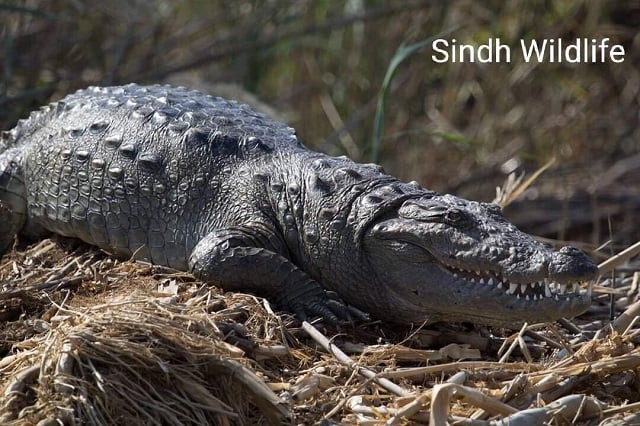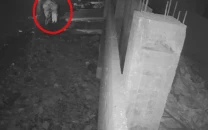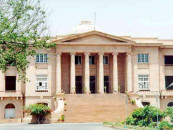Marsh crocs thriving in the wild
Over 200 sighted at Haleji Lake, as many more at Nara Wetland Complex

SUNBATHING: A crocodile basks in the sunlight at Haleji Lake. The reptiles are thought to be increasing in number at the wildlife sanctuary, as well as other areas in the province. PHOTO: COURTESY SINDH WILDLIFE DEPARTMENT
While there is no exact headcount of the reptiles at any of the locations, they are believed to be increasing in number in Haleji Lake, Nara Wetland Complex, Chotiari Wetland Complex, Wagni village near Ghotki and Hub Dam - their long-standing abodes in the wild.
Making an estimate, the Sindh wildlife department's (SWD) Sukkur deputy conservator said, "Roughly, over 200 crocodiles have been sighted in Haleji Lake and its surroundings and as many in Nara Wetland Complex." Adding that around 20 were sighted near Hub Dam a few years back, he clarified that these were just rough estimates and there was no exact tally of the wild crocodile population anywhere in the province.
Government making strides to preserve nature
"Crocodiles coming out of the water to bask at Haleji Lake is a sight to see," enthused SWD conservator Javed Ahmed Mahar. "Crocodiles opening their mouths, [resting under the sun] is called basking, [which] is a natural process," he went on to explain. "It reenergises them."Why did the population shrink?
Once, crocodiles were found in abundance in the region, said Mahar, but the population declined following the construction of a canal irrigation system.
"Besides, the fragmentation of their habitat, illegal hunting and illegal trade also contributed to their declining numbers. Eventually, they almost vanished from the wild," he elaborated, adding that historical records show that they also used to reside in creeks near Karachi.
Though illegal hunting has been banned, some hunters continue to target these animals to check their shooting skills, he added.
The expert further pointed out that some others killed them fearing that they would attack and hurt them. "But they [marsh crocodiles] are not aggressive and do not attack people. I have not heard of any incident of them attacking people," said Mahar.
Sindh’s only wildlife museum opens after 29 years
Further shedding light on their traits, he said that they were active scavengers with very strong immune systems, able to survive without food for at least a year.In captivity
Apart from their wild habitats, marsh crocodiles have also been living in captivity at various locations in Sindh. They are kept in Sufi Anwer Shah Safari Park in Ghotki, at a sanctuary at the site of Haleji Lake and at the shrine of Hazrat Khawaja Hassan in Manghopir, Karachi.
The famed crocodiles at the shrine in Manghopir are visited by scores of people who consider them sacred, according to Khalifo Sajjad, the shrine's caretaker. "They call for the crocodiles to come out and if the animals respond to their calls, they go home content, believing that their wish will be fulfilled," he explained.
According to Sajjad, around 150 crocodiles are kept at the shrine in a pond that covers less than an acre of land.
"They have been here for the past 800 years," he claimed, that people visiting them also fed them meat out of respect. However, he added, the lockdown did initially create a food shortage for the reptiles in the pond before meat was supplied for them by the Auqaf department.



















COMMENTS
Comments are moderated and generally will be posted if they are on-topic and not abusive.
For more information, please see our Comments FAQ